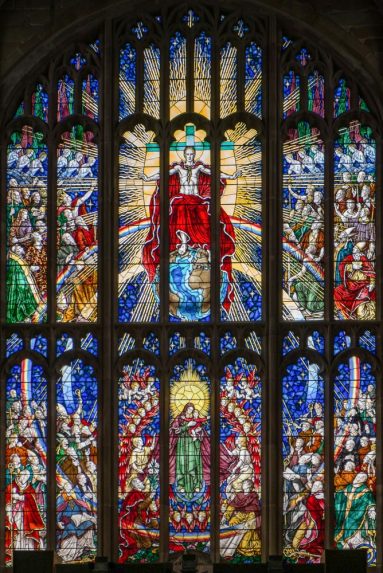Church of the Holy Trinity, Coventry, West Midlands (Warwickshire)
Address
Church of the Holy Trinity, 5a Priory Row, Coventry CV1 5EXRecommended by
Highlight
Te Deum west windowArtist, maker and date
Designed by Hugh Easton and made by Hendra & Harper, 1955Reason for highlighting
This large and colourful window is a typically dramatic and technically-brilliant window by Hugh Easton. It replaced Victorian stained glass which was destroyed by bombing in November 1940, and was dedicated in 1955.
It is a ‘Te Deum’ window, with a striking image of Christ in Majesty sitting on a rainbow, with his feet on the world in the upper tier. Rays of light emanate from Christ’s body. Below, historical figures from the story of the Christian church are depicted around the Virgin holding the Christ Child.
The beautifully translucent coloured glass, delicately silver staining, and sophisticated use of acid-etching on flashed glass reveals Easton’s virtuoso talent, even if some of the figure drawing is not to everyone’s taste!
Artist/maker notes
Hugh Easton (1906-65) learnt the craft of stained glass with the Guildford firm of George Blacking, before opening his first studio in Cambridge. After war work he returned to stained glass and a studio in London. He painted his early windows ,but soon found that if he found “an artist who could paint and interpret one’s drawings, a far greater technical mastery was achieved.”
Stylistically Easton’s work derives from Sir Ninian Comper and his pupil Christopher Webb with whom Easton was on ‘weekly visiting’ terms at Webb’s Orchard House Studio in St Albans.
Source: Hugh Easton by Caroline Swash, 2004 – Oxford Dictionary of National Biography
Hendra & Harper
Geoffrey Felix Harper (1913-66) and Robert Leslie Hendra (1912-1968) had a studio in Harpenden, Hertfordshire where they produced many windows for Hugh Easton, including his famous Battle of Britain window in Westminster Abbey.


Other comments
Another significant 1950s window is the East or “Brides” window, by Sir Ninian Comper. The window takes its name from the donations requested from couples marrying after the war. As in Easton’s west window, Christ is clean shaven, but the aesthetic is otherwise very different in this late work by Comper, with its more subdued colour scheme.
The church also has examples of the work of a number of the major Victorian firms, plus a panel of fragments of fourteenth century glass